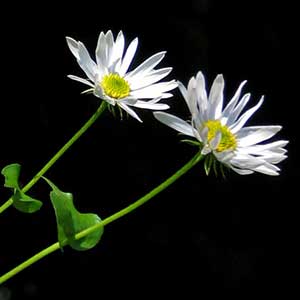Erigeron filifolius
Erigeron howellii
Peck's threadleaf fleabane
Howell's fleabane
Leaves both basal and cauline, linear or linear-filiform, 1-8 cm. long and 0.3-3 mm. wide, of uniform width.
Leaves alternate, thin, glabrous, the lower ones with an ellipitical blade 2-8 cm. long and 1.5-4.5 cm. wide, abruptly contracted to the 2-12 cm. petiole; middle cauline leaves ovate to cordate, strongly clasping at the base; upper leaves similar but smaller.
Heads solitary or several;
involucre 4-6 mm. high, with fine, soft hairs or small glands or both;
rays 15-125, blue, pink or white, 3-13 mm. long and 1-2 mm. wide;
pappus of 20-30 simple hairs.
Heads solitary; disk 12-20 mm. wide;
involucre bracts loose, equal, glandular, somewhat herbaceous;
rays 30-50, white, 13-25 mm. long and 2-4 mm. wide; disk corollas yellow, 4-5 mm. long, the lobes flaring;
pappus simple, of 20-30 capillary bristles.
Achenes asymmetrically 5-nerved.
Erigeron filifolius
Erigeron howellii
- Local floras:
BC,
CA,
OR,
WA
- Local Web sites:
CalFlora,
CalPhotos,
Flora NW,
PNW Herbaria,
Turner Photog.
WildflowerSearch
iNaturalist (observations)
USDA Plants Database
- LBJ Wildflower Center
- SEINet
- Plants of the World Online
- Encyclopedia of Life
- Wikipedia
- Google Image Search



